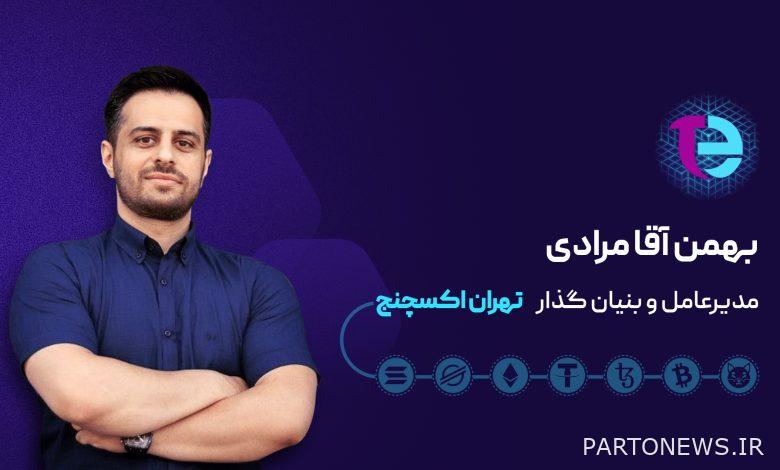A conversation with the founder of Tehran Exchange; The story of the formation of a different platform

One of the main challenges that both users and business owners in the digital currency space are dealing with is the limitations associated with the form of activity of centralized trading platforms; Restrictions such as requiring authentication in traditional centralized exchanges that are in clear contradiction with online privacy. Or more importantly, traditional centralized systems depend on the trust factor, which means that the user has no choice but to trust the operators of that project to entrust their personal information and assets to a platform.
For this reason, there has always been a lack of systems in this space that preserve the privacy of users and generally require lower levels of trust; Platforms that, in addition to solving the challenges of traditional systems, are optimized for easy use by users.
Over the past years, various examples of decentralized or trustless trading platforms have been developed by teams from around the world, and many of them have now achieved some level of stability in hosting their users. In Iran’s digital currency space, however, in recent years, few businesses have thought of developing decentralized or at least less centralized examples of trading platforms, and this issue has caused the concerns of some of the users of this space, who for reasons such as restrictions related to free internet access from internal platforms used, remain unresolved.
In this article, we have talked with the founder of Iran’s first decentralized and non-trust exchange. Bahman Aghamoradi, founder and CEO Tehran Exchange In this interview, he talks about how the idea of setting up a different platform inside the country was formed and talks about the solutions of this team to solve the basic concerns of the users of domestic exchanges.
Interview with CEO of Tehran Exchange; The formation of a different platform
Aghamardai has been familiar with various financial markets such as forex since 2005 and has started his activity in the online startup space of the country since 2008. 2015 was the beginning of his familiarity with Bitcoin and digital currencies. At the end of that year, Aghamoradi entered the field of Bitcoin mining and in 2016 he worked professionally and on a large scale in this field.
His entry into the space of digital currency exchange, however, was keyed by the feeling of emptiness and numerous restrictions in this field inside the country.
Aghamoradi says about this:
Around 2016, many exchanges were not active in Iran. During that period, several exchanges were limited and manual for users’ buying and selling, and from the very beginning, many restrictions were felt in the field of exchange. Since 2017, the problem of international sanctions has been added to these restrictions and, for example, the Bitrex exchange blocked the assets of its Iranian users under the pretext of sanctions.
He said about the formation of the idea of starting Tehran Exchange:
Seeing these limitations, I decided to gather a team and present a product that is not repetitive, has creativity in it, and we can do reverse engineering on their structure by seeing the international products of this field and finally be able to present a new product.
Aghamardai says about Tehran Exchange choosing a different path from other trading platforms in the country:
In the first stage, we planned to launch a spot market, which currently has many similar ones; But in those years, active programmers in the blockchain field had little experience and references were limited, and we might face problems in the discussion of wallets. At that time and unfortunately even now for some exchanges, wallets and withdrawals from the accounts of users affiliated with other exchanges were made. Therefore, we felt the risk and came to the conclusion that in such a model, the maintenance of users’ property may face serious challenges. All in all, we decided to spend our money on reverse engineering active projects and finally moved from launching a spot market to offering a non-trust and decentralized product.
The CEO of Tehran Exchange believes that the risks of setting up such a system were much higher than similar examples that have been active for years and are still active now. He says that since most users tend to trade in rial markets, the risk of entering the traditional model was lower and the expected income was higher. According to Aghamoradi, the team of Tehran Exchange has finally had to make a decision to choose between considering the market conditions at that point or creating an innovation and developing it until reaching a point to compete with international examples.
The CEO of Tehran Exchange explains in this regard:
In the development of Tehran Exchange, we accepted the risk of abandoning rial receipt and tried to move users to decentralized markets more easily. Our goal was not to store any data from the user and simply use a set of tools so that the processes have the concept of being decentralized. We focused on strong support, easy follow-ups, and removing complex processes for users in making transactions.
As it was said at the beginning, Tehran Exchange team has been active in the space of digital currencies since 2016, but the presentation of the current version of this platform after the changes that were made to optimize it, finally happened in 1401.
Features of Tehran Exchange and future plans

From the beginning of the formation of the digital currency ecosystem, there have been discussions about the centralization or decentralization of different projects or the degree of concentration in each project or product, and perhaps it can be said that there is a completely clear and inclusive definition for lack of concentration in different categories and especially for all active products in this space. does not have.
This also applies to the form of activity of decentralized exchanges, and there are disagreements about which protocol and how decentralized it is. Naturally, Tehran Exchange, which presents itself as a decentralized and non-trust exchange, has faced these challenges.
Agha Moradi has said regarding the discussion of concentration and lack of concentration in the key processes of Tehran Exchange:
There are many definitions of decentralized platforms. In Tehran Exchange, however, we have used decentralized mechanisms and tools for most of the processes, but in some parts we have had to use centralized systems. Despite this, programming has been done in such a way that it does not threaten users and we have programmed the main core ourselves. It can be said that 80% of the processes in Tehran Exchange are decentralized and the rest of the processes are still done in a non-trusted manner. For the decentralized parts that are dependent on liquidity pools, we have used decentralized exchange aggregators (DEX Aggregators).
The form of activity, especially Tehran Exchange, has created certain competitive advantages for this platform compared to centralized platforms and even existing international examples. According to Agha Moradi, the issue of sanctions is still a serious threat for Iranian users and there are always risks for operating in centralized foreign exchanges, and unfortunately, these international platforms do not have a commitment to their Iranian users for these reasons.
Agha Moradi says that in Tehran Exchange, the user has been assured that he can get help from the support team in case of any problem, and the issue will be followed up until the result is obtained.
In addition, lack of authentication, lack of restrictions on the volume of transactions, support for various blockchain networks, the possibility of cross-chain exchange, as well as the possibility of converting a large number of different currency pairs to each other, are the characteristics that make Tehran Exchange to the extent It distinguishes a lot from other exchanges.
Finally, the most important issue for most users is the exchange rate and the issue of fees. Aghamoradi says about the mechanism of setting rates and receiving fees from Tehran Exchange traders:
Tehran Exchange uses decentralized exchange aggregators in its exchanges, and the fees of different liquidity pools have some influence on the rates. Finally, all the fees of the liquidity pools are calculated and added to the wallet transfer fee and displayed to the user. 0.05% in floating rate and 0.1% in fixed rate model are also charged from the user. Despite this, we are upgrading the infrastructure of Tehran Exchange so that we can make the final rate better than before and be able to offer better rates compared to foreign models and even centralized exchanges, and this is one of our main and short-term goals.
Aside from the discussion of rates, the out-of-pocket cost of trading on centralized exchanges is usually not considered. For example, Agha Moradi has given an example of a situation in which a user intends to convert Ripple token to “BNB” using a centralized exchange. In this situation, the user must first deposit his Ripples to the exchange by paying a fee from his personal wallet. Since the “XRP/BNB” currency pair may not be available on all exchanges, you should first convert your Ripple to a base currency such as Tether and then buy BNB with your Tethers on another market. Finally, a fee must be paid for withdrawal from the exchange.
Aghamardai says that the Tehran Exchange team did not stop after developing their exchange and this platform is not their first and last product. In addition to Tehran Exchange’s efforts to provide better and competitive rates, this team plans to open its decentralized staking service and non-trusted multichain wallet in the near future.
The CEO of Tehran Exchange says about the legal conditions of the non-trust model of Tehran Exchange’s activity:
The team of Tehran Exchange cooperates with FATA police like other domestic exchanges and has not faced any challenge in this regard. However, we have a plan in case we need to explain to the legal authorities, while maintaining the decentralized nature of Tehran Exchange, by using illegal transaction tracking tools, we will not allow abuse of the platform and address the legislator’s concerns.
Agha Moradi added at the end:
I hope that the legislation for this space as well as the new systems will be done in such a way that the progress of this field will not be stopped. Considering the amount of capital available to Iranian exchanges, domestic platforms could be among the best examples in the world and not be so dependent on foreign exchanges. Rigid regulations, especially for new startups, can worsen this environment, increase monopoly in this market, and thus prevent the development of domestic collections by reducing competition. I hope we will see the growth of the blockchain space in Iran, because I believe there is a lot of potential in this field in the country, especially among the young generation. In my opinion, Iran could become the center of digital currency and blockchain technology in the region before the UAE, but I think this has not happened so far due to the slow actions of the officials or the desire of some people to operate in the gray area. I hope we can use this space so that people are driven to work in various sectors of blockchain technology and businesses and developers are not forced to leave the country.

